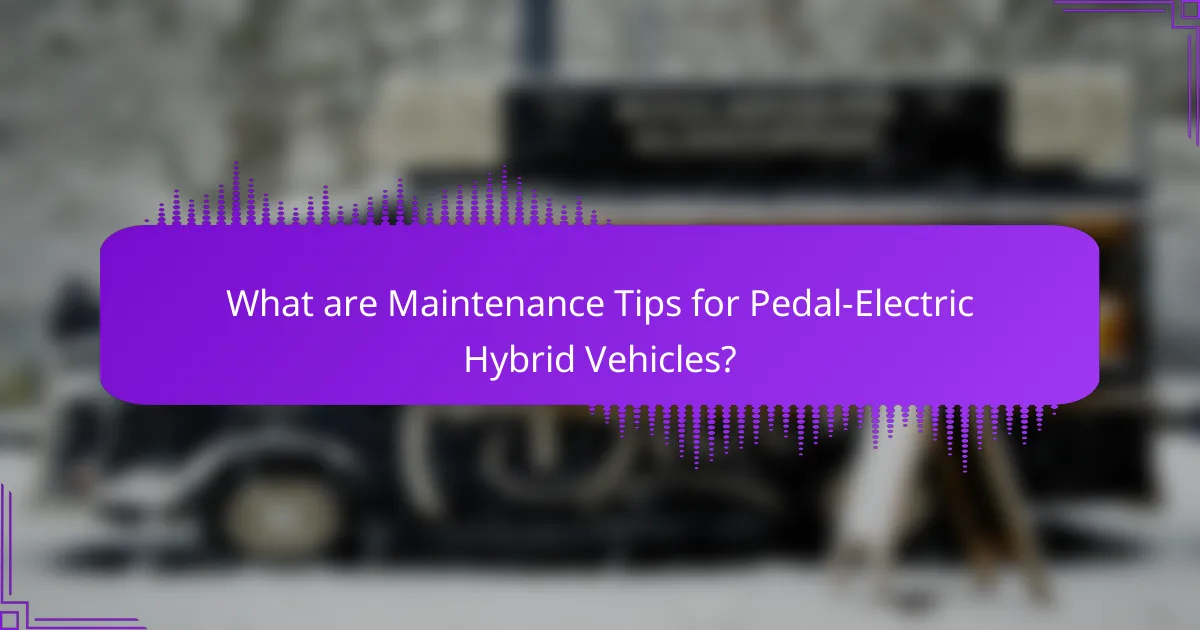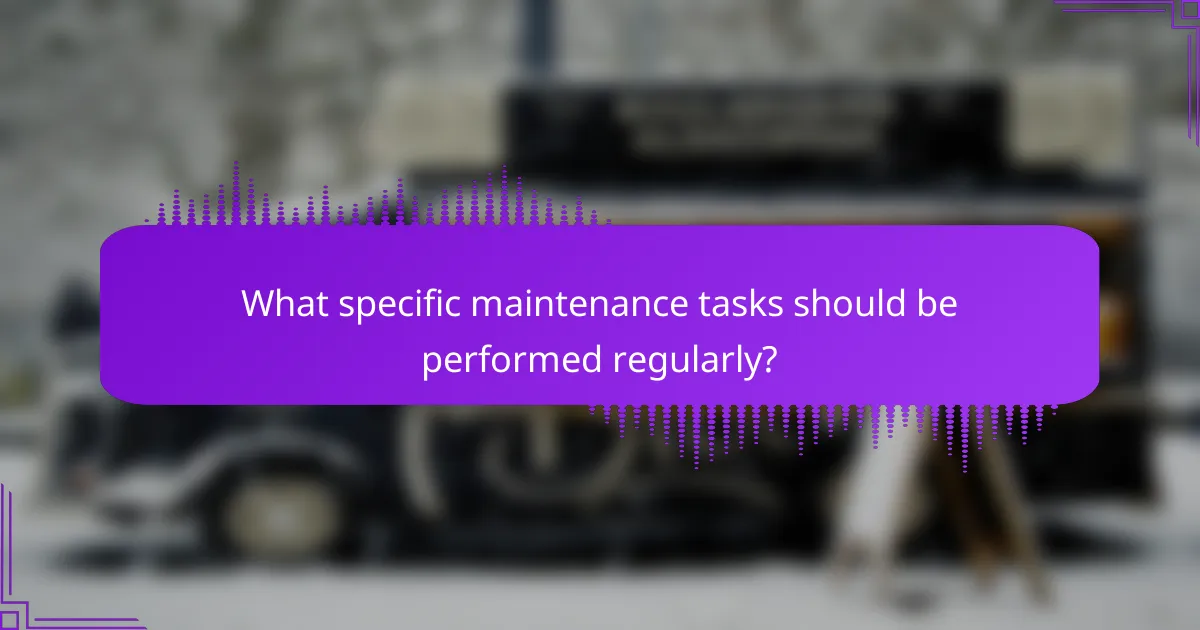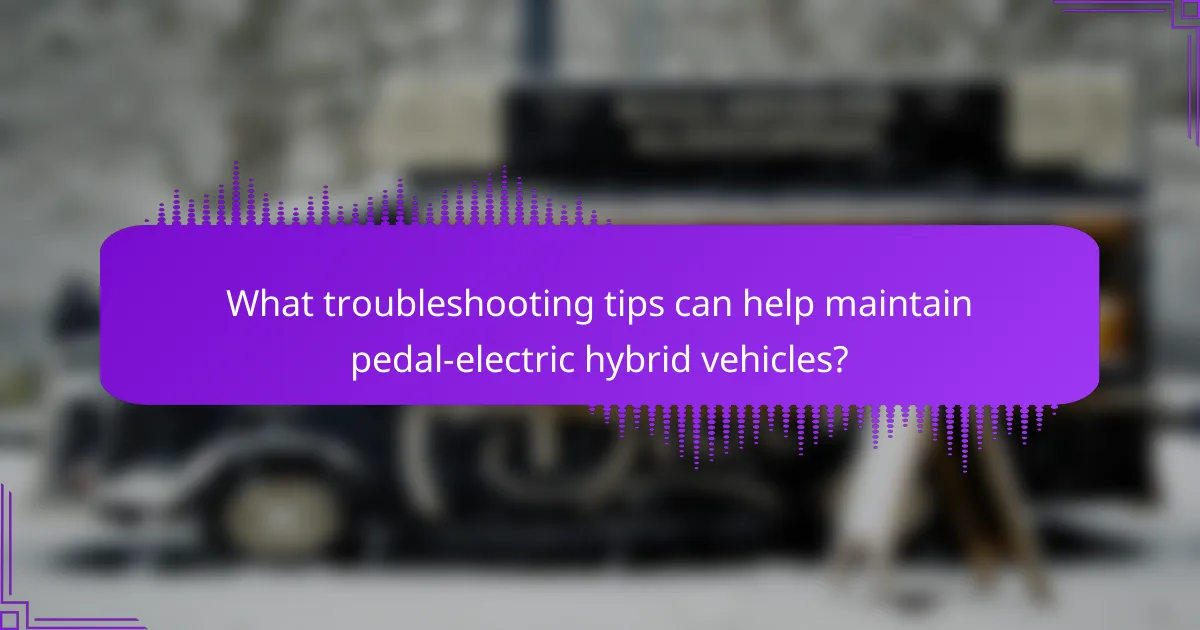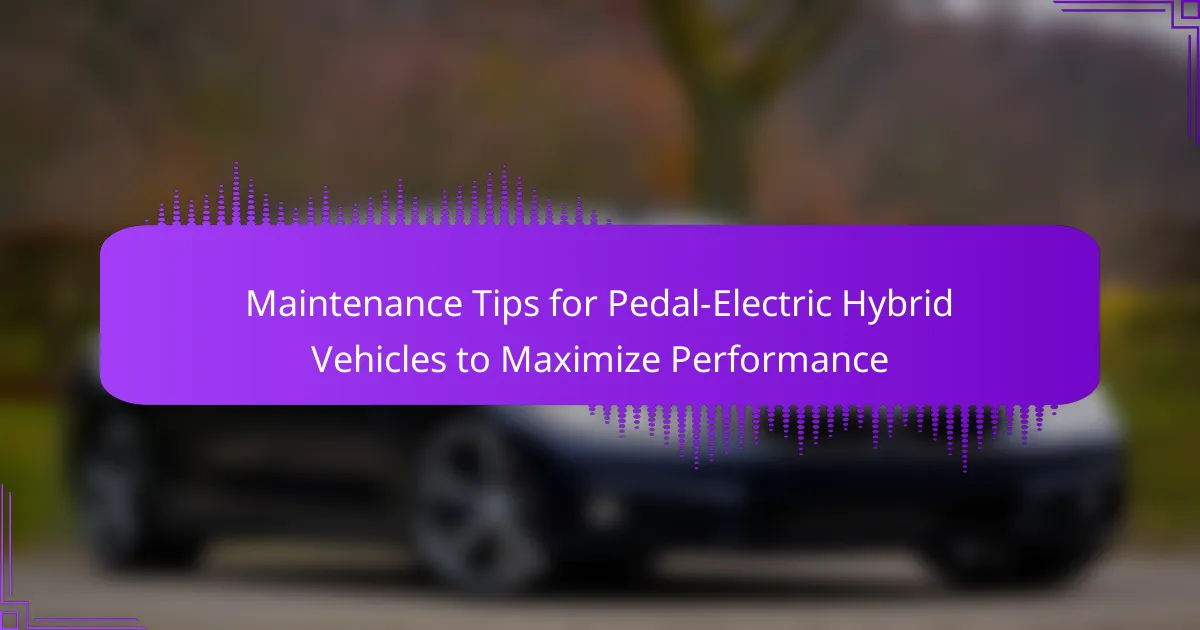
What are Maintenance Tips for Pedal-Electric Hybrid Vehicles?
Regular maintenance of pedal-electric hybrid vehicles is essential for optimal performance. Check tire pressure monthly to ensure proper handling and efficiency. Inspect brakes regularly for wear and replace them when necessary. Clean the electric motor and battery connections to prevent corrosion. Monitor battery health and charge cycles to extend lifespan. Lubricate moving parts, such as the chain and gears, to enhance performance. Ensure that the pedals and drivetrain are functioning smoothly. Follow the manufacturer’s service schedule for comprehensive inspections. These practices contribute to the longevity and efficiency of pedal-electric hybrid vehicles.
How do maintenance practices enhance the performance of pedal-electric hybrid vehicles?
Maintenance practices enhance the performance of pedal-electric hybrid vehicles by ensuring optimal functionality of both the electric and mechanical systems. Regularly checking and maintaining the battery can prolong its lifespan and efficiency. Proper tire inflation and tread depth improve traction and reduce rolling resistance. Routine cleaning of electrical connections prevents corrosion and ensures reliable power transfer. Maintaining the drivetrain components minimizes energy loss and enhances responsiveness. Additionally, regular software updates can optimize the vehicle’s management systems for better performance. These practices collectively contribute to improved energy efficiency and overall vehicle performance.
What are the key performance indicators for pedal-electric hybrid vehicles?
Key performance indicators for pedal-electric hybrid vehicles include battery efficiency, range, and weight. Battery efficiency measures how effectively the vehicle converts electrical energy into usable power. Range indicates the distance the vehicle can travel on a single charge or pedal assist. Weight affects overall performance, influencing speed and handling. Other important indicators are motor power output and regenerative braking efficiency. Motor power output determines acceleration capabilities. Regenerative braking efficiency assesses how well the vehicle recovers energy during braking. These indicators collectively define the performance and usability of pedal-electric hybrid vehicles.
How does regular maintenance influence these performance indicators?
Regular maintenance significantly improves performance indicators of pedal-electric hybrid vehicles. It enhances battery efficiency, ensuring optimal power usage during rides. Regular checks of tire pressure and tread depth increase traction and safety. Scheduled inspections of the electrical system prevent unexpected failures. Routine cleaning of components minimizes wear and tear, extending vehicle lifespan. Fluid checks and replacements ensure smooth operation of mechanical parts. Consistent maintenance leads to better fuel efficiency, reducing overall operational costs. Studies show that well-maintained vehicles can achieve up to 20% better performance metrics compared to neglected ones.
Why is it important to maintain pedal-electric hybrid vehicles?
Maintaining pedal-electric hybrid vehicles is crucial for optimal performance and longevity. Regular maintenance ensures that the electric and mechanical components function efficiently. This can lead to improved energy efficiency and reduced operational costs. Neglecting maintenance may result in decreased battery life and reduced overall vehicle performance. Additionally, proper care can enhance safety features and driving experience. Studies indicate that well-maintained hybrid vehicles can achieve up to 20% better fuel economy. Routine checks can identify potential issues before they escalate, saving time and money. Regular maintenance also helps in maintaining the vehicle’s resale value.
What are the long-term benefits of regular maintenance?
Regular maintenance of pedal-electric hybrid vehicles leads to enhanced performance and longevity. It reduces the risk of unexpected breakdowns by identifying issues early. Regular checks on battery health can extend its lifespan significantly. Routine maintenance also ensures optimal efficiency, resulting in better energy consumption. Furthermore, consistent upkeep can enhance safety features, reducing accident risks. Studies show that vehicles with regular maintenance have a higher resale value. These benefits collectively contribute to lower overall ownership costs over time.
How does maintenance impact the lifespan of pedal-electric hybrid vehicles?
Maintenance significantly impacts the lifespan of pedal-electric hybrid vehicles. Regular maintenance ensures optimal performance and prevents premature wear. Key tasks include battery care, tire maintenance, and brake inspections. A well-maintained battery can last up to 1,000 charge cycles, while neglected batteries may fail much sooner. Proper tire inflation enhances efficiency and extends tire life. Routine brake checks prevent costly repairs and ensure safety. Research indicates that consistent maintenance can increase vehicle lifespan by 20-30%. Overall, diligent maintenance practices are essential for maximizing the longevity of pedal-electric hybrid vehicles.

What specific maintenance tasks should be performed regularly?
Regular maintenance tasks for pedal-electric hybrid vehicles include checking tire pressure, inspecting brakes, and ensuring battery health. Maintaining proper tire pressure enhances fuel efficiency and safety. Brake inspections are crucial for safe operation and performance. Battery health checks prevent unexpected failures and extend lifespan. Additionally, regular cleaning of electrical connections ensures optimal performance. Routine lubrication of moving parts reduces wear and tear. Following the manufacturer’s maintenance schedule is essential for reliability. These tasks collectively support the vehicle’s efficiency and longevity.
How often should the battery of a pedal-electric hybrid vehicle be checked?
The battery of a pedal-electric hybrid vehicle should be checked at least every six months. Regular inspections help ensure optimal performance and longevity of the battery. Monitoring battery health can identify issues early. This practice aligns with manufacturer recommendations for maintenance. Checking the battery every six months allows for timely replacements if necessary. Routine checks can prevent performance degradation and enhance overall efficiency. Regular maintenance contributes to the vehicle’s reliability and safety.
What are the signs of battery wear or degradation?
Signs of battery wear or degradation include reduced capacity, increased charging time, and diminished performance. A battery that can no longer hold a charge effectively indicates capacity loss. If a battery takes longer to charge than usual, it may signal degradation. Additionally, a noticeable drop in power output during use suggests that the battery is not performing optimally. Physical signs such as swelling or leakage also indicate serious wear. These symptoms are commonly observed in lithium-ion batteries, which are often used in hybrid vehicles. Regular monitoring of these signs can help maintain battery health and performance.
How can battery maintenance affect overall vehicle performance?
Battery maintenance directly impacts overall vehicle performance. A well-maintained battery ensures optimal energy delivery to the electric motor. This results in improved acceleration and responsiveness. Regularly checking battery connections prevents power loss due to corrosion. Maintaining proper battery charge levels enhances the lifespan and efficiency of the vehicle. A fully charged battery can provide maximum range, which is crucial for hybrid vehicles. Neglecting battery maintenance may lead to reduced performance and increased wear on the vehicle’s components. Studies show that consistent battery care can lead to a 20% increase in efficiency.
What tire maintenance practices are essential for pedal-electric hybrid vehicles?
Regular tire pressure checks are essential for pedal-electric hybrid vehicles. Maintaining the correct tire pressure improves fuel efficiency and extends tire life. Under-inflated tires can lead to increased rolling resistance. This results in higher energy consumption. Over-inflated tires may cause uneven wear and reduce traction. Checking tire pressure monthly is recommended. Additionally, rotating tires every 5,000 to 7,500 miles promotes even wear. Inspecting tires for tread depth and damage is also crucial. Tread depth affects grip and safety. Lastly, aligning the wheels helps prevent uneven tire wear. Proper alignment ensures optimal handling and performance.
How does tire pressure affect efficiency and safety?
Tire pressure significantly affects both efficiency and safety in vehicles. Proper tire pressure ensures optimal contact with the road. This contact improves fuel efficiency by reducing rolling resistance. Under-inflated tires increase fuel consumption by up to 3% for every 1 psi drop in pressure. Additionally, correct tire pressure enhances vehicle handling and stability. It reduces the risk of tire blowouts, which can lead to accidents. Over-inflated tires can also compromise safety by decreasing traction. Maintaining recommended tire pressure promotes longer tire life and better overall performance. Regular checks are essential, as tires naturally lose air over time.
What are the best practices for tire rotation and alignment?
The best practices for tire rotation and alignment include regular checks and adjustments. Tire rotation should occur every 5,000 to 7,500 miles. This ensures even tire wear. Additionally, alignment should be checked at least once a year or if you notice uneven tire wear. Proper alignment improves vehicle handling and fuel efficiency. Misalignment can lead to premature tire wear and decreased performance. Regular maintenance can extend the life of your tires and enhance safety. Following these practices helps maintain optimal performance in pedal-electric hybrid vehicles.

What troubleshooting tips can help maintain pedal-electric hybrid vehicles?
Regularly check the battery levels in pedal-electric hybrid vehicles. Low battery levels can affect performance and range. Ensure that the tires are properly inflated to the recommended pressure. Under-inflated tires can lead to decreased efficiency and handling. Inspect the brakes for wear and functionality. Worn brakes can compromise safety and performance. Clean the electrical connections and components to prevent corrosion. Corroded connections can lead to electrical issues. Monitor the drivetrain for unusual noises or vibrations. These can indicate mechanical problems that need addressing. Schedule routine maintenance checks with a qualified technician. Regular inspections can help identify potential issues early.
How can drivers identify common issues in pedal-electric hybrid vehicles?
Drivers can identify common issues in pedal-electric hybrid vehicles by monitoring performance indicators. Unusual noises during operation may signal mechanical problems. A decrease in battery efficiency can indicate battery degradation. Warning lights on the dashboard often point to specific issues needing attention. Drivers should regularly check tire pressure and tread depth for safety. Inspecting brake responsiveness is essential for safe driving. Unexplained increases in energy consumption may suggest a malfunction. Regular maintenance checks can help catch these issues early.
What are the warning signs of electrical system problems?
Warning signs of electrical system problems in pedal-electric hybrid vehicles include flickering lights, which indicate potential voltage issues. Additionally, a burning smell may suggest overheating wires or components. Unresponsive controls can signal electrical failures in the system. Frequent blown fuses often point to excessive current draw. Lastly, a warning light on the dashboard typically indicates a fault in the electrical system. Recognizing these signs is crucial for timely maintenance and avoiding further damage.
How can performance issues be diagnosed effectively?
Performance issues can be diagnosed effectively by following a systematic approach. Start by checking the vehicle’s battery status. A low battery can lead to reduced performance. Next, inspect the electrical connections for any signs of corrosion or damage. Faulty connections can disrupt power delivery. Additionally, evaluate the motor and controller for any error codes. These codes provide specific information on performance issues. Conduct a visual inspection of the drivetrain components for wear or damage. Worn parts can affect overall performance. Finally, perform a road test to assess the vehicle’s responsiveness and handling. This hands-on evaluation can reveal issues that may not be apparent through diagnostics alone.
What best practices should be followed for optimal vehicle upkeep?
Regular maintenance is essential for optimal vehicle upkeep. This includes checking and changing the oil every 5,000 to 7,500 miles. Tire pressure should be monitored monthly to ensure safety and fuel efficiency. Brake pads and fluid levels need inspection at least twice a year. Battery health should be assessed regularly, especially in hybrid vehicles. Cleaning the air filter every 12,000 miles can improve engine performance. Additionally, keeping the exterior clean protects the paint and prevents rust. Following the manufacturer’s service schedule enhances vehicle longevity. Regular maintenance can increase a vehicle’s resale value significantly.
How can regular cleaning improve the performance of pedal-electric hybrid vehicles?
Regular cleaning improves the performance of pedal-electric hybrid vehicles by removing dirt and debris that can hinder efficiency. Clean components, such as the electric motor and battery, allow for better energy transfer. This leads to enhanced acceleration and overall responsiveness. Additionally, a clean exterior reduces drag, contributing to improved aerodynamics. Regular maintenance can also prevent corrosion on electrical connections, ensuring optimal functionality. Studies show that well-maintained vehicles can achieve up to 10% better fuel efficiency. Therefore, consistent cleaning is essential for maintaining peak performance in pedal-electric hybrid vehicles.
What tools are essential for DIY maintenance of pedal-electric hybrid vehicles?
Essential tools for DIY maintenance of pedal-electric hybrid vehicles include a multi-tool, tire pressure gauge, and a basic toolkit. A multi-tool allows for quick adjustments and repairs. A tire pressure gauge ensures optimal tire inflation for safety and performance. A basic toolkit should contain wrenches, screwdrivers, and pliers for various tasks. Additionally, a bike stand facilitates easier access to the vehicle for maintenance. A battery charger is also important for maintaining electric components. These tools enable effective upkeep and enhance the vehicle’s longevity and performance.
Pedal-electric hybrid vehicles are increasingly popular for their efficiency and performance, making regular maintenance vital for optimal functionality. This article outlines essential maintenance tips, including tire pressure checks, battery health monitoring, and brake inspections, to enhance vehicle longevity and performance. Key performance indicators, such as battery efficiency and range, are discussed alongside the impact of maintenance on these metrics. Additionally, troubleshooting tips and best practices for upkeep are provided to help drivers identify and address common issues effectively. Overall, consistent maintenance practices are crucial for maximizing the performance and lifespan of pedal-electric hybrid vehicles.
